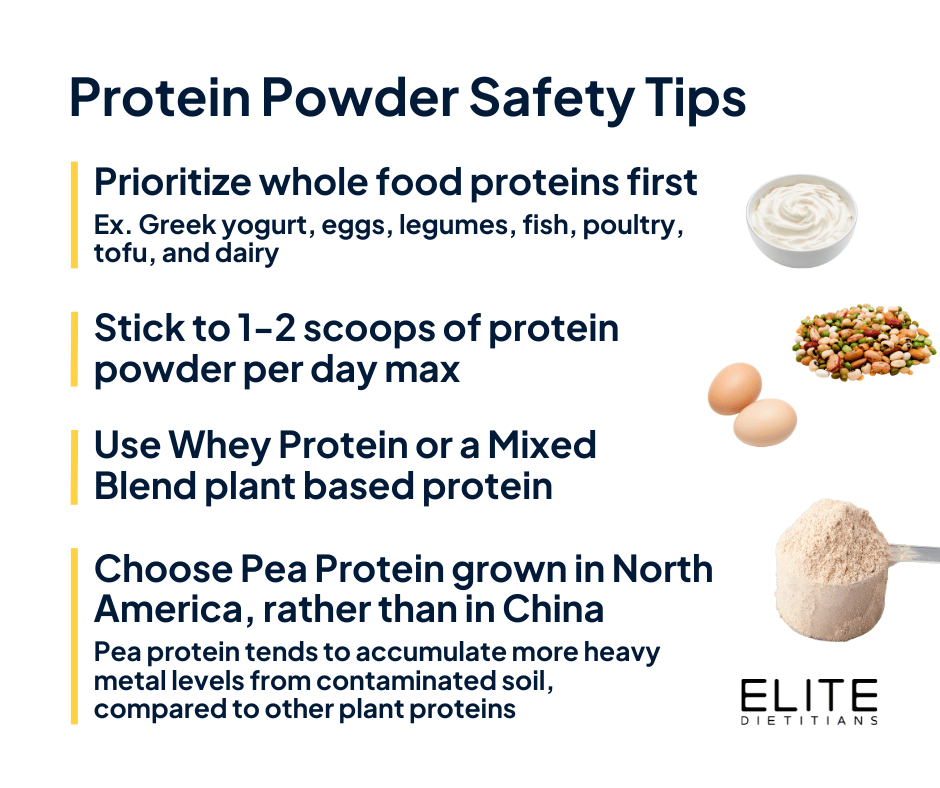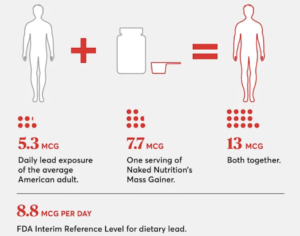Protein powders have become a staple in many households; they are routinely used by teen athletes, busy professionals, and health-conscious consumers. But a recent investigation by Consumer Reports has revealed that most protein powders contain concerning levels of lead, a toxic heavy metal. Here is what you need to know about lead in protein powders.
Before you panic and throw away your protein tub, let’s unpack what this study actually means, and what’s worth worrying about.
Results of the Consumer Report
Consumer Reports tested 23 popular protein powders and ready-to-drink shakes.
More than two-thirds contained more lead per serving than what their experts considered safe for daily use.
“It’s concerning that these results are even worse than the last time we tested,” said Tunde Akinleye, CR’s food safety researcher.
That sounds alarming, but there’s more to the story. As a sport dietitian, I took a closer look at the report and found a few important limitations that change how we interpret these results.
Three Limitations of the Consumer Report (CR) Results:
Limitation 1: Serving sizes weren’t standardized
CR compared lead per serving, even though serving sizes varied drastically. For example:
| Product | Serving Size (g) | Lead (µg per serving) | Lead (µg per 100g) |
|---|---|---|---|
| Naked Vegan Mass Gainer | 315 | 7.7 | 2.4 |
| Garden of Life Sport | 45 | 2.76 | 6.1 |
| Huel Black Edition | 90 | 6.3 | 7.0 |
When you adjust for serving size, Naked Vegan Mass Gainer actually has less lead per gram than other powders that were listed as “safer.”
So, the way the data was compared can be misleading. It’s not always about how much is in a serving, but how concentrated it is by weight.
Table 1. Level of lead measured in protein powder samples by ConsumerReports.org
Limitation 2: CR used an extremely strict safety limit
There’s no federal limit for lead in protein powders. Instead, Consumer Reports used California’s Proposition 65 benchmark of 0.5 µg per day, which is much lower than what other authorities consider safe.
| Standard | Allowable Lead (µg per serving) |
|---|---|
| CR “Level of Concern” | 0.5 |
| FDA (for drugs and supplements) | 5.0 |
| NSF Certified Supplement limit | 10.0 |
The National Sanitation Foundation (NSF) International certification is an independent organization that tests and certifies dietary supplements against specific standards set by the group, to ensure they meet rigorous safety standards.
FDA has set Interim Reference Level (IRL) based on the total intake of lead that leads to concentrations of lead in the blood associated with negative health effects. These reference levels are designed to protect pregnant women and children from lead toxicity:
- Children: 2.2 µg per day
- Women of childbearing age: 8 µg per day
- Adults: 12.5 µg per day
Note that the IRLs reflect total exposure per day, rather than per serving of one product.
Limitation 3: Trace metals exist naturally in food
Lead and other heavy metals occur naturally in soil and water, so achieving zero-level exposure is impossible. The average American adult is exposed to up to 5.3 micrograms (µg) of lead each day through their diet, according to a 2019 analysis published by scientists at the FDA.
Estimated Lead Levels in Common Foods vs Protein Powders
| Source | Lead (µg per 100g or serving) |
|---|---|
| Fruits | 0.2 |
| Vegetables | 0.3 |
| Grains | 0.4 |
| Seafood | 0.5 |
While protein powders varied widely from 0-7 µg per serving, the vast majority were less than 1 µg per serving.
So, if your protein powder adds another 1 µg per scoop, your total is still comfortably under the daily reference level of 8 µg for adults.
We get it, Lead Is Dangerous
Chronic lead exposure has been linked to immune suppression, reproductive problems, kidney damage, and high blood pressure in adults. Children and pregnant people are most vulnerable because lead can potentially cause neurological issues, developmental delays, and learning delays.
Should You Be Concerned?
Not really, unless you’re pregnant, breastfeeding, or using protein powder for young children. In those cases, it’s worth choosing more carefully or consulting your healthcare provider.
As a sports dietitian, I find Consumer Reports’ interpretation unnecessarily fear-based. The data shows variation between brands, yes, but not a level of risk that justifies panic.
For example, CR exaggerated the risk when they referenced a serving size of 6 scoops of Naked Nutrition Mass Gainer to demonstrate an excess of lead intake below:
What This Means for You
Companies Can Source Clean Protein
Vegan protein powders can be very nutritious and have a strong following. I predict that consumer demand will create change in manufacturing processes long before there are government safety regulations.
By highlighting the variability in lead levels in protein powders, CR has provided manufacturers with an opportunity to source their proteins from “clean” sources. Brands like Vega and Momentous have already taken steps to reduce lead levels by switching to North American-grown pea protein, which comes from cleaner soil sources. We can expect more companies to follow as consumers become more aware.
Food First Approach
Protein powders are a convenient way to get a serving of protein in a quick snack or smoothie on the go. Remember that most protein powders do not give us the full nutrient profile that we get from whole foods and are not a substitute for balanced meals. If you’re relying on multiple scoops every day, it might be time to refresh your meal plan or chat with a dietitian for easy, high-protein food swaps.
My Recommendations as a Sport Dietitian
Don’t let these fear-based headlines scare you away from using your protein powder.

As a Sport Dietitian, I recommend:
- Prioritize whole food proteins first (Greek yogurt, eggs, legumes, fish, poultry, tofu, and dairy).
- Use up to 1-2 scoops of protein powder per day.
- Rotate protein powders or use a mixed plant-based protein.
- Look for pea protein powders sourced from North America.
- Whey protein powder.
FAQ
Why does pea protein contain more lead than whey protein?
Plant protein powders contain more lead than whey protein powders because pea plants naturally absorb minerals and contaminants from the soil. Pea protein processing concentrates the nutrients and, unfortunately, also the contaminants. In contrast, contaminants are filtered through animal biology before entering cow milk in the case of whey protein.
Also, much of the pea protein used in supplements is imported, often from countries with less stringent soil and water regulations. For example, some pea protein comes from China, where soil contamination is a known issue. [newlifelongevity.com]
How much protein do women need during menopause?
See my blog on How Much Protein You Need During Menopause
How much protein do teen athletes need?
See my blog on How Much Protein Do Athletes Need?










